INSTRUCTION TO CANDIDATES:
- Answer all the questions in the spaces provided.
- All questions to be answered in English.
- Read all questions carefully.

QUESTIONS
-
- State the use of a sweep net ’. (1 mark).
- State two main branches of Biology. (2 marks).
- Name the organelle that performs each of the following functions in a cell.
- Protein synthesis. (1 mark).
- Transport of cell secretions. (1 mark).
- The diagram below represents a certain organism.
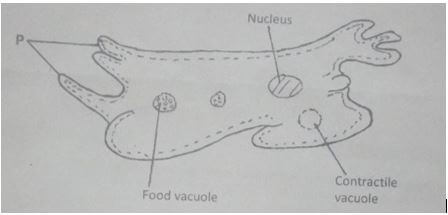
- Identify the kingdom to which the organism belongs. (1 mark).
- Identify the part labeled P.
- What is the function of contractile vacuole? (1 mark).
- Other than carbon (IV)oxide, name other products of anaerobic respiration. (2 marks).
-
- Name the fluid that is produced by sebaceous glands. (1 mark).
- State one functions of sweat in the human body. (1 mark).
-
- State two characteristics that are used to divide the phylum Arthropoda into classes. (2 marks).
- Name the class with the largest number of individuals in the phylum arthropoda. (1 mark).
- Why are people with blood group O referred to as universal donors? (1 mark).
- An experiment was set up as shown in the diagram below.
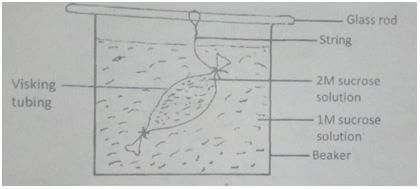
- Which process is being investigated by the above experiment? (1 mark).
- State the expected results. (1 mark).
- Explain your answer in (b) above.(2 marks).
-
- What causes the following diseases? (1 mark).
- Diabetes mellitus.
- Diabetes insipidus.
- How would you test that someone is a victim of Diabetes mellitus in the laboratory. (3 marks).
- What causes the following diseases? (1 mark).
- The following chart shows a feeding relationship in ecosystem.
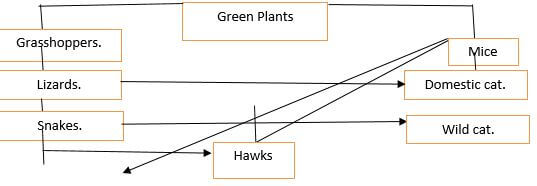
- Construct two food chains ending with a tertiary consumer in each case. (2 marks).
- Which organism has the largest variety of predators in food web? (1 mark).
- Suggest three ways in which the ecosystem would be affected if there was prolonged drought.(3 marks).
- Some of the fish found in Lake Victoria include;
- Tilapia zilli
- Lates niloticus
-Oreochromis niloticus
-Tilapia leucastica
-Tilapia variabilis- From the names above, suggest which of the fish are most closely related. (3 marks).
- Give a reason for your answer (1 mark).
- Define the term species (1 mark).
- The diagram below shows a mature embryo sac of a flowering plant.
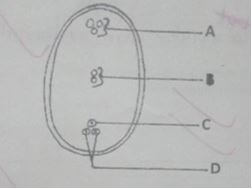
- Name the parts labelled A and D. (2 marks).
A……………………………………………
D…………………………………………… - What is the function of the structure labeled B. (1 mark).
- Name the parts labelled A and D. (2 marks).
-
- Name the tissues that transport water in plants. (1 mark).
- How is the tissue you named in (a) above strengthened? (1 mark).
- The diagram below shows regions of growth in a root. Study it and answer the questions that follow.
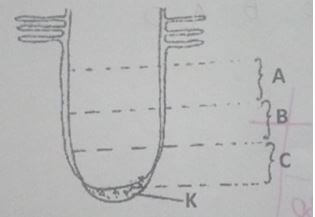
- Name the zones labelled. (3 marks).
A……………………………………………
B……………………………………………
C…………………………………………… - State the function of part K. (1 mark).
- Name the zones labelled. (3 marks).
- The enzymes pepsin and trypsin are secreted in their inactive forms.
- Give the names of these inactive forms. (2 marks).
- Why are they secreted in an inactive form? (1 mark).
-
- A student drew 6cm long diagram of a plant flower. If the actual length of the flower was 12cm calculate the magnification of the drawing made by the student. (Show your working). (3 marks).
- Name a vitamin and an ion important in blood clotting (2 marks).
Vitamin……………………………
Ion…………………………………
- The diagram below represents a model used to demonstrate breathing in mammals. Study it and answer the questions that follow.
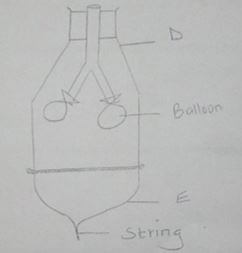
- Name the mammalian structure represented by the parts labelled D and E. (2 marks).
D………………………………………………
E……………………………………………. - State the observation made when the string is pulled downwards. (1 mark).
- Explain the observation in (b) above. (2 marks).
- Name the mammalian structure represented by the parts labelled D and E. (2 marks).
- Study the diagram of the mammalian tooth below and answer the questions that follow.
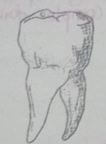
- Identify the tooth. (1 mark).
- Give a reason for your answer in (a) above. (1 mark).
- State one adaptation of the tooth to its function. (1 mark).
- The diagram below shows gaseous exchange in tissues.
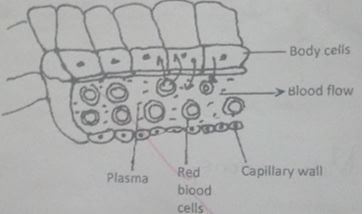
- Name the gas that diffuses.
- To the body cells……………………………………………………………………………………………… (1 mark).
- From body cells………………………………………………………………………………………………. (1 mark).
- Which compound dissociates to release the gas named in (a)(i) above. (1 mark).
- What is tissue fluid? (1 mark).
- Name the gas that diffuses.
- The diagram below represent one of the specialized cells found in the human body.
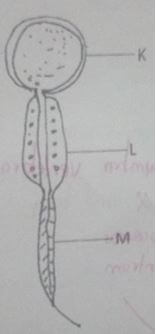
- Identify the cell? (1 mark).
- What is the function of the cell? (2 marks).
- Name the parts labelled:
K…………………………………… (1 mark).
L…………………………………… (1 mark).
M……………………………………(1 mark).
- A student set up an experiment using soaked dry seeds as shown below.
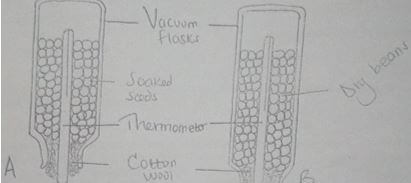
- State the objective of this experiment (1mark)
- State the observations made in each of the flasks after 24 hours (2marks)
Flask A……………………………………………
Flask B…………………………………………… - account for the observation made in flask A (2marks)
- suggest why vacuum flasks were used in this experiment (1mark)
- The table provided below shows the concentration of sodium and iodine in sea water and cell sap of a plant
Sodium ion concentration
Iodide ion concentration
Sea water
250
35
Cell sap
100
550
-
- Name the process through which the plant cells take up sodium ions (1 mark).
- Give a reason for your answer in (a) (i) above (1 mark).
- If the plant was sprayed with a chemical that inhibits respiration.
- Which of the two ions uptake will be affected? (1 mark).
- Give a reason for your answer in (b) (i) above (1 mark).

MARKING SCHEME
-
- Catching of flying insects. (1mark).
-
- Botany (1 mark).
- Zoology (1 mark).
- Microbiology(1 mark).
-
- Ribosome (1 mark).
- Golgi apparatus (1 mark).
-
- Kingdom Protoctista / Protista (1 mk). Reject small p.
- Pseudopodia (1 mark).
- Excretion of excess water (1 mark).
-
- Energy (1 mark).
- Ethanol (1 mark).
-
- Sebum (1 mark).
-
- Regulate the body temperature by cooling the body (1 mark).
- Excretion of mineral salts (Any one correct).
-
-
- Number of limbs.
- Number of body parts.
- Number of body segmentation (2 marks).
- Insecta (1 mark). Reject small i
-
- They lack antigen in their blood hence no antigen antibody reaction hence donating to all blood groups (1 mark).
-
- Osmosis (1 mark).
- The visking tubing becomes turgid (1 mark).
- Water molecules move from the solution in the beaker by osmosis to the visking tubing making it to become turgid. This is because the solution in the beaker is hypotonic to the solution in the visking tubing. (2 marks).( NB: a, b and c are tied answers).
-
-
- Inadequate secretion of insulin in the pancreas (1 mark).
- Inadequate release of Antidiuretic hormone in the pituitary gland (1 mark).
- Take a sample of urine in a test tube
Add equal amount of Benedict’s solution. Reject small b for Benedict’s and reject if there is no apostrophy ‘
Heat the mixture to boil.
Presence of orange colour indicates presence of glucose in the urine hence Diabetes Mellitus (3 marks).
-
-
-
- Green plants → mice → snakes → hawks (1 mark).
- Green plants → mice → snakes → wild cat (1 mark).
- Mice (1 mark).
-
- All green plants would dry up hence all consumers would decrease.
- Some organisms would starve to death leading to decrease in population.
- Some organisms would migrate hence decrease in population (3 marks).
-
-
-
- Tilapia zilli.
- Tilapia leucastica.
- Tilapia variabilis (3 marks).
- They belong to the same genus (1 mark).
- Group of organisms which can naturally interbreed to give vise to viable offsprings (1 mark).
-
-
-
- Antipodal cells (1 mark).
- Synergids (1 mark).
- Fuses with one male nuclei to produce a triploid endosperm nucleus (1 mark).
-
-
- Xylem tissues (1 mark).
- They are lignified along the walls (1 mark).
-
-
- A-cell differentiation (1 mark).
- B-cell elongation (1 mark).
- C- cell division (1 mark).
- Protect the apical meristem from mechanical damage (1 mark).
-
-
-
- Pepsinogen (1 mark).
- Trypsinogen (1 mark).
- To prevent the digestion of cells that produce them (1 mark).
-
-
- Magnification = Drawing length (1 mark)
Length of the object
=6/12
=× 0.5 or × ½ (2 marks). Reject if × is missing. -
- Vitamin k (1 mark).
- Calcium ions Ca2+ (1 mark).
- Magnification = Drawing length (1 mark)
-
-
- D-Ribcage (1 mark).
- E- Diaphragm (1 mark).
- The balloons inflate (1 mark).
- This is because there will be an increase in volume and decrease in pressure inside the bell jar. Air would move into the balloons. (2 marks).
-
-
- Premolar (1 mark). Reject plural.
- Has two roots (1 mark).
- Has a large and flat surface to increase the surface area for grinding (1 mark)
-
-
- Oxygen gas (1 mark).
- Carbon (IV) oxide gas (1 mark). Reject (iv) for Carbon (IV) oxide.
- Oxyhaemoglobin (1 mark). Reject wrong spelling
- Fluid formed from the capillaries after ultrafiltration has taken place (1 mark).
-
-
- Sperm cell /spermatozoa (1 mark). Reject plural.
- Fertilises the ovum to produce a zygote (2 marks).
-
- K- Head.
- L- Middle piece.
- M- Tail. (3 marks).
-
- To show that germinating seeds produce heat when they respire (1 mark).
-
- Flask A- There will be a rise in temperature (1 mark).
- Flask B- Temperature remained constant (1 mark).
-
- Soaked seeds germinated respiring the food stored in seeds to produce energy:
- Part of this energy occurs as heat, the heat causes a rise in temperature in the thermometer(2 marks).
-
-
- Diffusion (1 mark).
- Its highly concentrated in the seawater than it is in the cell sap (1 mark).
( i and ii are tied).
-
- Iodide ion (1 mark).
- Uptake of the iodide ion require energy (1 mark).
Download Biology P1 Questions and Answers - Form 3 Term 3 Opener Exams 2022.
Tap Here to Download for 50/-
Get on WhatsApp for 50/-
Why download?
- ✔ To read offline at any time.
- ✔ To Print at your convenience
- ✔ Share Easily with Friends / Students

